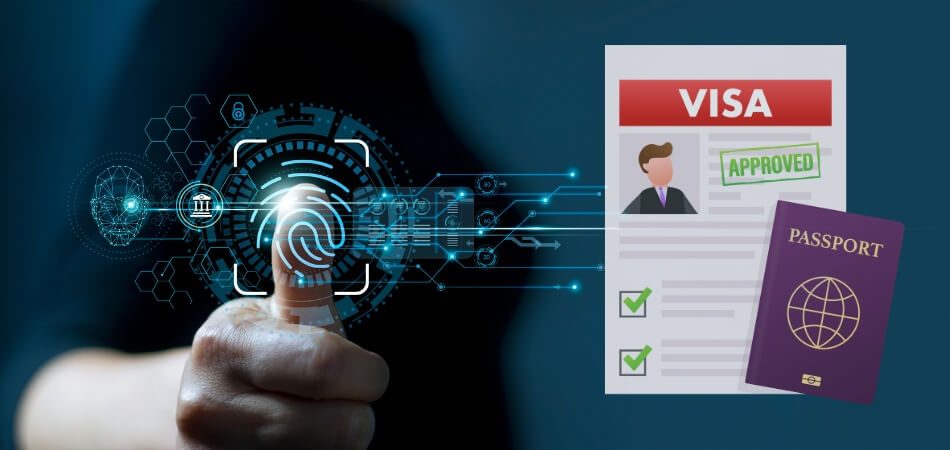Learning how to deal with the intricacies of international travel can be challenging, particularly when it comes to understanding visa applications and requirements. A common question among travelers seeking entry into Canada is, “Does Canada visa processing start after biometrics?”
Yes indeed, this query is fundamental to the application process. Biometrics, a critical component in establishing identity, are essential for the Canadian visa application. Once submitted, they mark a significant milestone in the journey towards obtaining a visa.
This blog aims to explore the role of biometrics in the Canadian visa process, shedding light on how and when the processing of your application commences post-biometric submission, and what applicants can expect thereafter.
A Brief Summary of the Canadian Visa Processing System
The Canadian visa process initiates with the submission of the required documents and application forms. This step is crucial, as it lays the groundwork for the subsequent stages of the visa evaluation. Following this, applicants undergo biometric data collection, which is a pivotal part of the identity verification process.
Once biometrics are collected, the actual processing of the visa application begins. This phase involves a detailed assessment of the submitted documents and biometric information, particularly crucial for those joining conferences from overseas. The final decision, made after comprehensive scrutiny, is communicated to the applicant, marking the end of the visa processing journey.
Requirements for Completing the Canadian Visa Processing
Embarking on the journey to acquire a Canadian visa involves meeting specific criteria and following a set of steps. This process is designed to ensure applicants meet Canada’s standards for entry. Here, we outline the key requirements that applicants must fulfill:
- Complete and submit the appropriate visa application form accurately, ensuring all personal information and travel details are correct. This form is the foundation of your visa request.
- Provide valid travel documents, such as a passport, that meet Canada’s standards for international travel. These documents are essential for identity verification.
- Submit recent photographs that comply with the Canadian visa photo specifications. These photos are crucial for the biometric verification process.
- Pay the necessary visa application fee, which varies depending on the type of visa and the applicant’s nationality. This fee is mandatory for processing the application.
- Attend a biometrics appointment for fingerprinting and a photograph, if required by the Canadian visa policy. This step is vital for security checks.
Adhering to these requirements is crucial for a successful Canadian visa application. Each step is designed to ensure the safety and proper management of the visa process, aligning with Canada’s immigration policies.
Does Canada Visa Processing Start After Biometrics?
Yes, the processing of a Canada visa typically begins after the completion of biometrics. This step is crucial as it verifies the applicant’s identity and is a pivotal part of the application.
- Submission of Application: The first step is submitting the visa application along with the necessary documents. This submission lays the groundwork for the entire process, ensuring all requirements are met.
- Biometrics Appointment: Following the application submission, applicants must attend a biometrics appointment. This involves capturing fingerprints and a photograph, essential for identity verification and security purposes.
- Application Processing: Post-biometrics, the visa processing officially commences. During this phase, the submitted documents and biometric data are thoroughly assessed by immigration officials.
- Decision and Communication: The final step involves the decision on the visa application. Applicants are notified of the decision, marking the conclusion of the visa processing journey.
- Additional Checks and Verification: In some cases, additional background checks or information may be required. These checks are conducted to ensure compliance with Canadian immigration policies and security standards.
- Issuance of Visa: If the application is approved, the visa is then issued. The visa outlines the terms of entry, including duration and purpose, aligning with the applicant’s intended travel plans.
The Canadian visa process is a multistep procedure that emphasizes security and proper vetting. Beginning in earnest after biometrics, it involves various checks and assessments, culminating in the issuance of a visa for eligible applicants. Understanding these steps helps applicants manage the process more effectively.
What Makes Biometrics Important in Canadian Visa Processing?
Biometrics have become a cornerstone in modern visa processing, especially in the context of Canadian immigration. This technology enhances security measures and streamlines the identification process. Understanding its significance provides insight into Canada’s commitment to efficient and secure immigration procedures.
Enhanced Identity Verification
Biometrics play a crucial role in accurately verifying the identity of visa applicants. This technology uses unique physical characteristics, ensuring each applicant is distinctively identified. This process mitigates the risks associated with identity theft and fraudulent applications.
Security and Safety
The use of biometrics significantly bolsters the safety and security of Canadian borders. By cross-referencing biometric data with global databases, potential security threats can be identified and mitigated. This system is integral in maintaining the integrity of Canada’s immigration policies.
Streamlined Processing
Biometrics contribute to a more streamlined and efficient visa processing system. By digitizing identity verification, the process becomes faster and more accurate. This efficiency benefits both applicants and immigration authorities, reducing processing times and administrative burdens.
Consistency in Immigration Standards
Implementing biometrics ensures consistency in the visa application process. All applicants undergo the same rigorous identity verification procedure, ensuring fairness and uniformity. This consistency is crucial in upholding the principles of equitable immigration practices.
Future-Proofing Immigration Systems
As technology evolves, biometrics keep the Canadian visa processing system adaptable and future-proof. This technology is scalable and can integrate with emerging security technologies, maintaining Canada’s position at the forefront of immigration innovation.
Biometrics are a vital component of the Canadian visa processing system, providing enhanced security, efficiency, and fairness. Their integration into the immigration process underscores Canada’s commitment to maintaining robust and forward-thinking border control measures. This technology not only streamlines the process for applicants but also plays a significant role in safeguarding the nation’s borders.
How to Complete the Canadian Visa Processing Properly?
Successfully managing the Canadian visa processing system requires following specific steps methodically. This process, while intricate, can be managed smoothly with the right guidance. Here, the following step-by-step guide aims to provide clear directions for completing this process effectively:
Step-1. Determine Visa Type
First, identify the type of Canadian visa that suits your travel purpose. Whether it’s for tourism, work, or study, selecting the correct visa category is essential. This choice determines the specific requirements and documentation needed.
Step-2. Gather Necessary Documents
Collect all required documents, including a valid passport, travel itinerary, and financial proof. Ensure these documents are up-to-date and accurately reflect your personal and travel details. Missing or incorrect documents can lead to application delays or rejection.
Step-3. Complete the Visa Application Form
Fill out the visa application form with precise and truthful information. Review it thoroughly before submission to avoid errors. Inaccuracies or incomplete forms can result in processing delays.
Step-4. Pay the Visa Fee
Calculate the correct visa fee for your application and make the payment. Keep the receipt as proof of payment, as it may be required during the application process. Fee payment is a mandatory step in the visa application process.
Step-5. Schedule and Attend Biometrics Appointment
If required, schedule your biometrics appointment at the nearest visa application center. Attend the appointment for fingerprinting and photographing. This step is crucial for identity verification and security checks.
Step-6. Submit the Application
After gathering all documents and completing biometrics, submit your visa application. You can submit it either online or at a visa application center, depending on the visa type. Ensure that all steps are completed before submission.
Step-7. Track the Application and Await Decision
Once submitted, track your application’s progress online. Be patient, as processing times can vary based on the visa type and individual circumstances.
Completing the Canadian visa process properly involves careful preparation, accurate documentation, and following each step diligently. By adhering to these guidelines, applicants can enhance their chances of a successful visa application, paving the way for their planned journey to Canada.
Complications You Might Face While Going Through the Canadian Visa Processing
Applicants may encounter various complications when dealing the Canadian visa processing system. These issues often stem from misunderstandings of the process or unforeseen circumstances. Awareness of these potential hurdles can help applicants prepare more effectively.
- Incomplete Documentation: A common issue is submitting incomplete or incorrect documentation. This oversight can lead to delays or even rejection of the visa application.
- Biometrics Appointment Delays: Biometrics appointments can be delayed due to high demand or limited availability. This delay can extend the overall visa processing time.
- Payment Issues: Problems with visa fee payments, such as incorrect amounts or failed transactions, can hinder the application process. Ensuring accurate and successful payment is crucial.
- Technical Glitches with Online Applications: Applicants may face technical issues when submitting applications online, such as website downtime or data entry errors. Regular checks and patience are essential.
- Visa Interview Challenges: Some visa categories require an interview, where misunderstandings or communication barriers can arise. Thorough preparation and clarity in responses are essential.
While the Canadian visa processing system is designed to be straightforward, applicants may face various complications. Awareness of these potential issues and preparing accordingly can significantly smooth the visa application journey. Patience, attention to detail, and adherence to guidelines are vital for managing this process successfully.
Final Thoughts
It’s clear that biometrics serve as the launching point for Canada’s visa processing, answering the critical query, “Does Canada visa processing start after biometrics?”
The articles provided offer a comprehensive view of this process, emphasizing the need for meticulous documentation, understanding the essential steps, and preparing for any hurdles that might come up.
This approach aids applicants in effectively maneuvering through the Canadian visa system. Recognizing the start of the processing post-biometrics is key, as it signifies the transition into a more focused and detailed evaluation phase. This knowledge equips travelers with the insight needed to successfully embark on their journey to Canada, starting with the crucial step of biometric submission.








